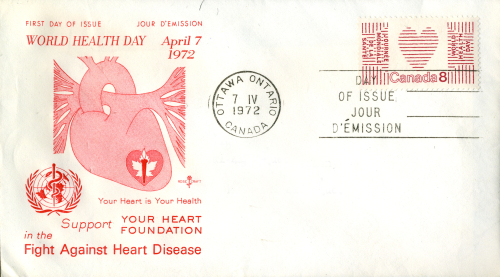
The Province of Canada issued its first postage stamp in 1851. Since then, the Government has printed thousands of stamps showing a wide variety of images. Many of these were designed to commemorate individuals, events, subjects and places which have been deemed meaningful to the Canadian people and their history. The subject of health care is an example of one of these.
The Maude Abbott Medical Museum has a collection of several hundred Canadian health care stamps and first day/souvenir covers. Fifty topics associated with these are shown in this exhibit. The selection and the grouping are somewhat arbitrary, but have been done to form four themes:
Many more individuals, diseases and organizations could be included but, for the most part, are yet to be recognized by a stamp or cover. Although quite eclectic, the subjects selected provide interesting “snapshots” of Canadian health care over the years. The beauty of the stamp and cover designs, when looked at carefully, is an additional feature worthwhile to explore.
Stamps are frequently embellished with images that illustrate their theme.

An example is the 2000 stamp featuring Frederick Banting, in which one can see his scientific collaborator, Charles Best, on the left. Below them are a dog and a syringe, the former presumably having surgically induced diabetes and the latter partially filled with insulin. The writing at the top is a copy of Banting’s hand-written notes on the experimental procedure used to obtain insulin. In the exhibit, we describe and attempt to interpret the many such embellishments that have been included by the stamps’ designers.
A first day cover (FDC) consists of a stamped envelope that has been franked (cancelled) on the first day the issue is used. The words “first day of issue – jour d’émission” are usually printed on or next to the stamp. Souvenir (commemorative) covers are similar to FDCs and are usually issued to coincide with the date of a specific event or anniversary that the stamp is marking. These typically have one or more images – cachets – related to the organization or event commemorated by the stamp.

1972 World Health Day first day commemorative cover showing a stylized heart and the logos of the World Health Organization and the Canadian Heart and Stroke Foundation prominently featured in the cachet.
Mailed stamps are usually cancelled by a postmark, showing that they have been used. The standard Circular Date Stamp includes the date and name of the town or city in which the letter was posted. Postmarks on commemorative covers often have an additional feature, such as an organization’s logo, to mark the event.

2001 first day cover commemorating the Canadian Medical Protective Association’s 100th anniversary. The Association’s logo is seen in the postmark.